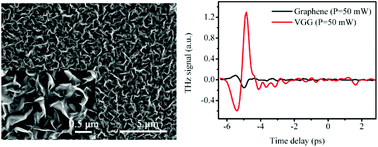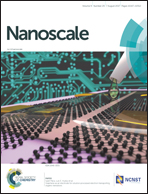Enhanced polarization-sensitive terahertz emission from vertically grown graphene by a dynamical photon drag effect†
Abstract
Improving terahertz (THz) emission from graphene is a challenge for graphene-based THz photonics as graphene demonstrates a weak light–matter interaction. With a unique ultra-black surface structure, vertically grown graphene (VGG) is proposed to enhance the light–matter interaction and further enhance THz emission. Herein, enhanced THz radiation is observed by THz time-domain emission spectroscopy from VGG compared with single-layer graphene. The radiated THz amplitude shows a linear dependence on pump power, which demonstrates a second order nonlinear effect. Considering the symmetry of VGG on a substrate, we can exclude the optical rectification effect and photogalvanic effect (PGE) by the D6h point group with centrosymmetry. Thus we analyze the transient photocurrent related to THz emission only by the photon drag effect (PDE). The polarization-sensitive THz radiation signals are wave-vector reliant and demonstrate cos 2φ and sin 2φ dependence on the polarization angles of the pump laser. This is consistent with the theoretical analysis of PDE. Our results show the enhanced, ultrafast, broadband THz radiation property of VGG, which paves the way for high performance THz emitters and THz detectors based on graphene materials.



 Please wait while we load your content...
Please wait while we load your content...